Much of the discussion around Intel’s current challenges is focused on manufacturing issues and its ongoing market share skirmish with AMD. Of course that’s understandable. But the core issue Intel faces is it has lost the volume game, forever. When it comes to silicon, volume is king. As such, incoming CEO Pat Gelsinger faces some difficult decisions. On the one hand, he could take some logical steps to shore up the company’s execution, outsource a portion of its manufacturing and make incremental changes that would please Wall Street and probably drive shareholder value when combined with the usual stock buybacks and dividends.
On the other hand, Gelsinger could make much more dramatic moves, shedding its vertically integrated heritage and transforming Intel into a leading designer of chips for emerging multi-trillion dollar markets that are highly fragmented and generally referred to as “edge opportunities.” We believe that Intel has no choice. It must create a deep partnership with a semiconductor manufacturer aspiring to manufacture on U.S. soil and, focus Intel’s resources on design.
In this Breaking Analysis we’ll put forth our prognosis for Intel’s future and lay out what we think the company needs to do to, not only maintain relevance, but regain the position it once held as perhaps the most revered company in tech.
Basic Economics of Semiconductor Manufacturing
Let’s explore some of the fundamental factors we’ve been tracking that have shaped and are shaping Intel today, and our perspectives.
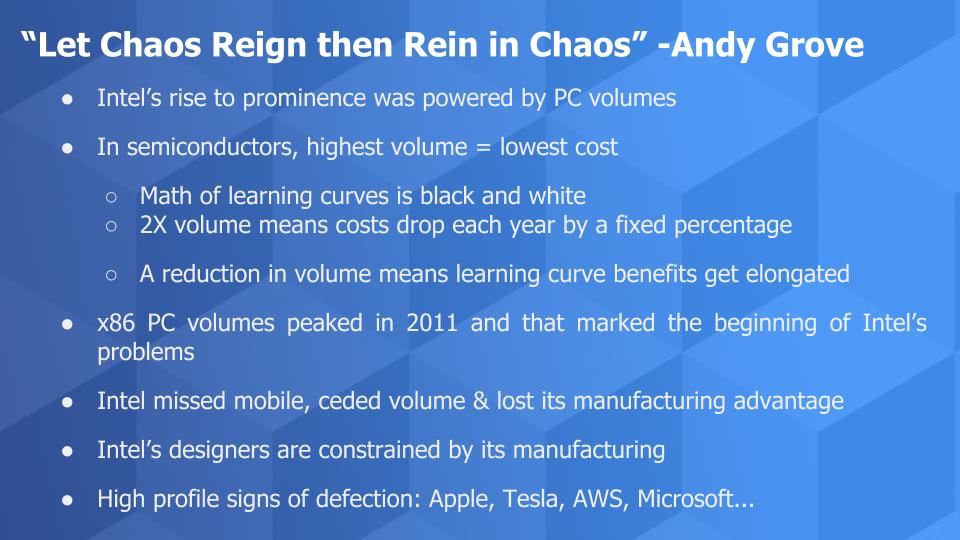
First, it’s important to point out that new CEO Gelsinger is walking into a really difficult situation. Some might say chaotic with lots of uncertainty.
Intel’s ascendency and manufacturing dominance was propelled by PC volumes, and its corresponding development of an ecosystem the company created around the x86 instruction set. Why is volume is so critical in semiconductors? It’s because the player with the highest volumes has the lowest manufacturing costs. While much has been written about achieving economies of scale with smaller fabs, the math around learning curves at volume is clear and compelling.
While most people are familiar with Moore’s Law, much of the theory around volume economics can be explained better with Wright’s Law, named after Theodore Wright – T.P. Wright – a prominent aeronautical engineer who in the mid-1930’s published a critical paper “Factors affecting the costs of airplanes.” The law projects manufacturing costs as a function of cumulative production volumes. Wright discovered that for every cumulative doubling of units manufactured, costs will fall by a constant percentage. The law articulates the benefits of moving up the experience curve (and consequently down the cost curve) and is highly applicable to semiconductor manufacturing. The law quantifies in manufacturing terms, what Amazon’s Andy Jassy often says about the evolution of cloud:
There’s no compression algorithm for experience.
In semiconductor wafer manufacturing, that cost decline from Wright’s Law is roughly 22% for a doubling of production. Meaning when your cumulative production doubles, you get the benefits of lower costs from experience. When you consider the economics of manufacturing a next generation semiconductor technology – for example going from 10 nanometers to 7 nanometer technology, this becomes huge. The cost of setting up 7nm tech is much higher relative to 10nm, so the constant in Wright’s Law becomes critical. Now if you can add to that the benefits of putting more circuits on a chip, your end costs of delivering processors can drop by 30-33%/year. The combination of learning curve effects and circuit density confer major advantages to the volume leaders. Consequently, if the time it takes to double volume is elongated, the learning curve benefits get pushed out; and you become less competitive from a cost standpoint. You can reach a stage where it will be impossible to implement new technology, because the volume is not sufficient to go down the learning curve quickly enough. This has happened in HDDs.
And this is what’s is happening to Intel.
Missed Opportunities, Designer Constraints & Defections
Intel famously missed mobile by passing on the iPhone opportunity. Intel, as did most, underestimated smartphone volume by 100X. As a result, it handed its volume advantage to its competitors. Personal computer manufacturing volumes peaked in 2011 and that marked the beginning of the end of Intel’s dominance. One can’t help but recognize the irony in that 25 years earlier, IBM unwittingly handed its monopoly to Intel and Microsoft.
Moreover, because Intel has a vertically integrated approach to design and manufacturing, its designers are limited by constraints in the manufacturing process. What used to be Intel’s ace in the hole, the best and lowest cost manufacturing, has become a headwind. This no doubt frustrates Intel’s chip designers and cedes advantage to a number of competitors, including AMD, Arm and Nvidia, along with their volume manufacturing partners like TSMC and Samsung.
Other evidence of Intel’s decline from prominence can be seen when observing what some of the highest profile innovators are doing in chip design, choosing to work with alternative suppliers and in many cases diversifying away from Intel. Companies like Apple, which chose its own design based on Arm for the M1. Tesla is a fascinating case study where it chose Arm-based components and its own design instead of chips from Mobileye (acquired by Intel). AWS, probably Intel’s largest customer is developing its own chips, many using Arm components. And just last month it was reported that Microsoft, Intel’s monopoly partner in the PC era, was developing its own Arm-based chips for the Surface PCs and servers.
Peak PC Volumes Signaled the Top
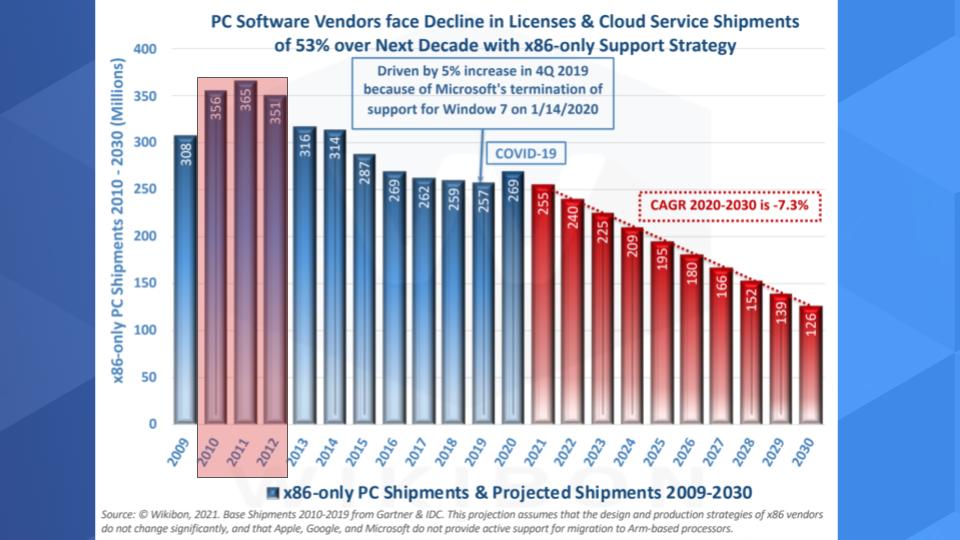
To stress the point, this chart above shows x86 PC volumes over time. The red highlighted area shows the peak years. PC volumes actually grew in 2020, in part due to COVID with the demand for laptops to support remote workers. But the rules of the volume game were already reset by mobile; and a decades-long the victory march to the cadence of the Moore’s & Wright’s Law are gone.
PC Markets are Actually Great…If You’re Dell
Below is a snapshot of ETR data showing Dell’s laptop Net Score or spending momentum for 2020 into 2021. Dell’s client business has been very good and profitable for the company. Frankly it’s been a pleasant surprise. PC’s are doing well as you can see by the unit growth on the insert. Approximately 275M maybe as high as 300M PC units shipped worldwide in 2020, up double digits by some estimates.
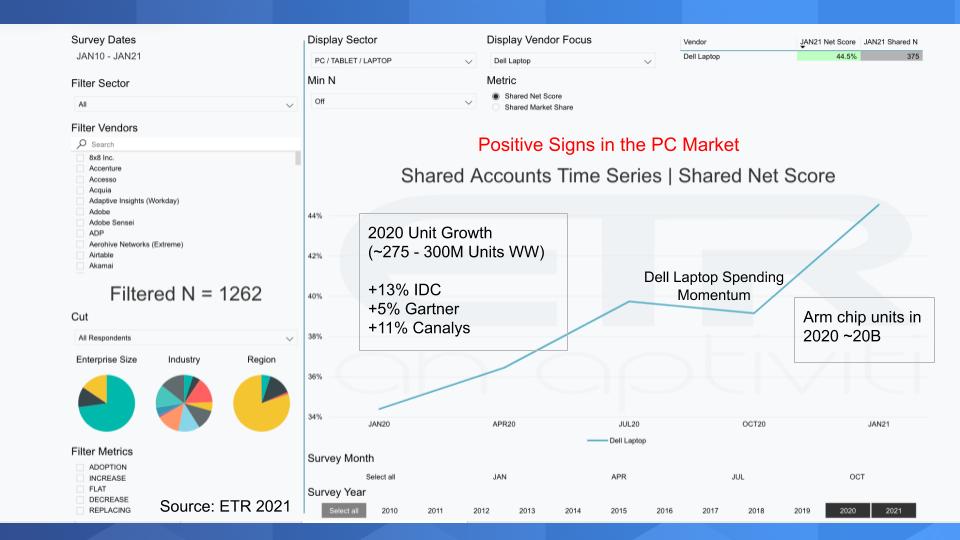
But in the all-important volume semiconductor manufacturing game, PCs are no longer the king. Collectively, Arm chip units surpassed 20B worldwide last year. While comparing Arm chips shipped to x86 PCs is not apples to apples, the numbers speak for themselves…
the wafer volume for Arm chips dwarfs that of x86 by a factor of 10X
Back to Wright’s Law. How long will it take Intel to double wafer volumes? Pat Gelsinger understands this dynamic probably better than anyone in the world – certainly better than we do.
Moreover, if you look at the performance and price performance of Arm compared to x86, the picture continues to favor Arm, quite dramatically. Arm design to production cycles are faster, the technology is climbing the learning curve faster and riding the cost curves down at a more accelerated rate.
Arm Encroaches on PCs
As you look out to the future the story for Intel’s PC dominance does not look promising.
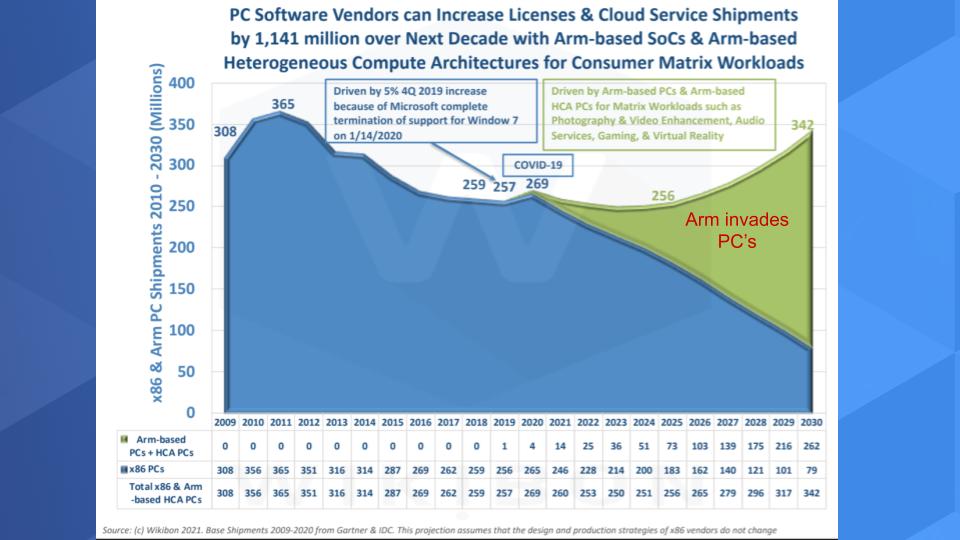
The chart above shows Wikibon’s 2020 forecast for Arm-based, compared to x86-based PCs. It also includes some other devices but you can see what happens by the end of the decade. As we’ve seen with the M1 at Apple, Arm is slowly eating away at PCs and much better positioned for these emerging devices that support things like video and virtual reality systems.
So again, the volume game is over for Intel and with it, the company’s manufacturing cost advantages. They’ll never win it back.
But Intel Still Dominates the Data Center, Right?
Yes, and that business generates much higher revenue per unit. But even so, we still see revenue from Arm-based systems surpassing that of x86 by the end of the decade as shown in the chart below. Arm compute revenue is shown in the orange area with x86 in the blue.
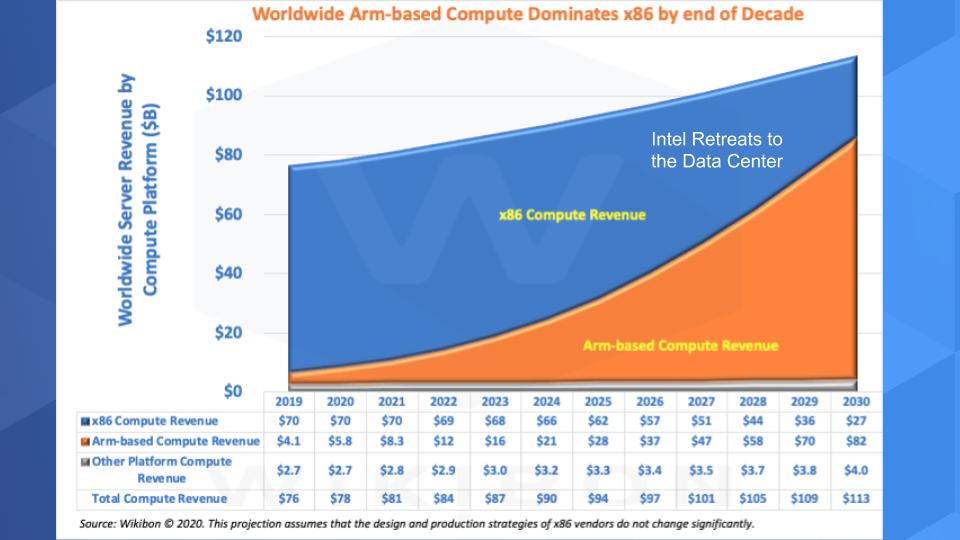
This means to us that Intel’s last moat will be its position in the data center. It has to defend that at all costs.
But that’s a near term play. We don’t think Pat Gelsinger is a defensive-minded general. On the contrary, he’s a masterful strategists who thrives on forward momentum. More on that later…
Comparative Valuations Reflect Intel’s Reality
Financial markets know there’s something wrong and you can see it reflected in the valuations of semiconductor companies.
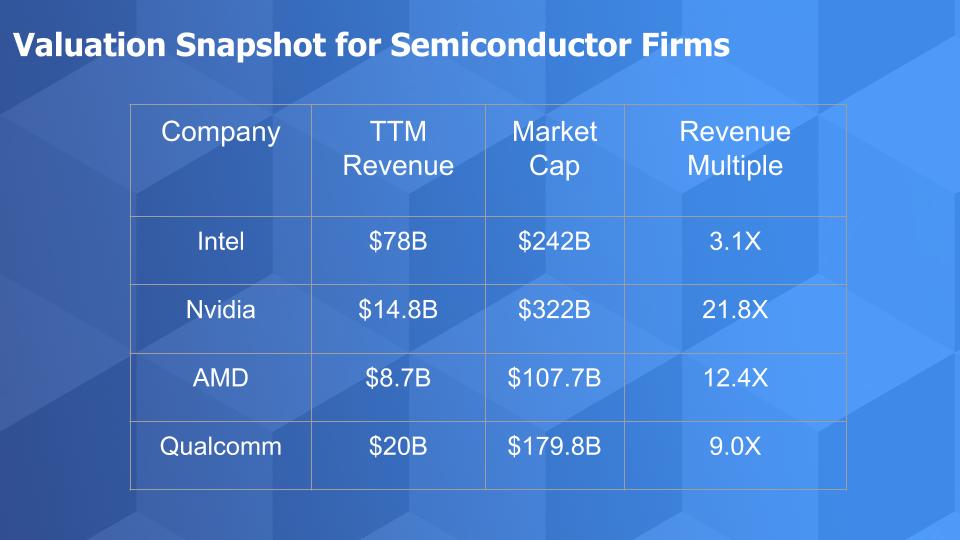
The chart above compares the trailing twelve month revenue and market valuations for Intel, Nvidia, AMD and Qualcomm. And you can see at a TTM revenue multiple of 3X, compared to about 22X for Nvidia and about 10X for AMD and Qualcomm, Intel is lagging behind.
Many View Intel as a Cheap Stock
The graph below shows Intel’s performance for the past twelve months compared to the Nasdaq and you can see the major divergence. The stock reacted very well to the appointment of Gelsinger, which is no surprise. It’s hard not to be sanguine about Pat’s decision to return to Intel.
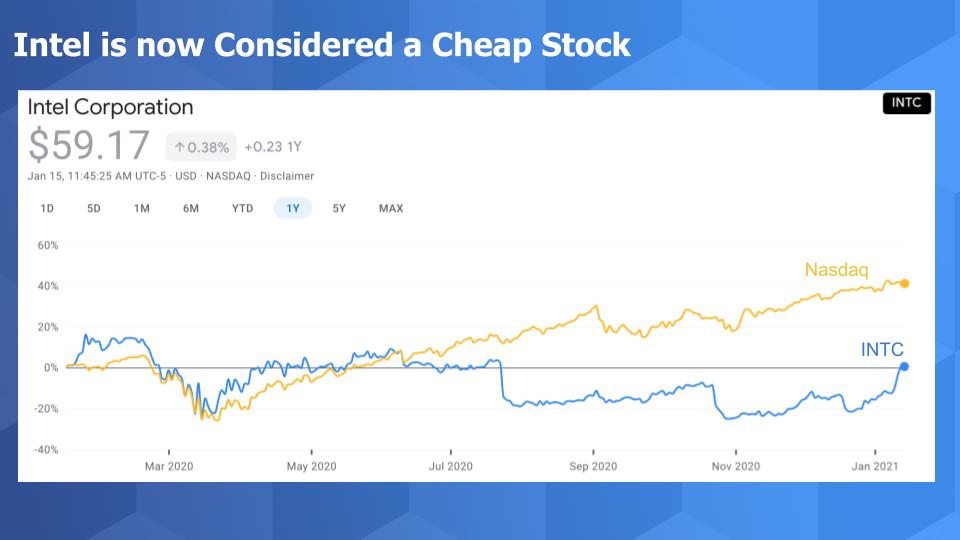
The question people are asking is what’s next for Intel. How will Pat turn the company’s fortunes around? How long will it take? What moves can he and should he make? How will they be received by the market and internally within Intel’s culture? Will things get worse before they get better?
Big Questions and a Spectrum of Answers
These are serious questions! And people are split on what should be done. We’ve heard everything from Pat should just clean up the execution issues and not make any major strategic moves to Intel should do a hybrid outsourced model to Intel aggressively move out of manufacturing.
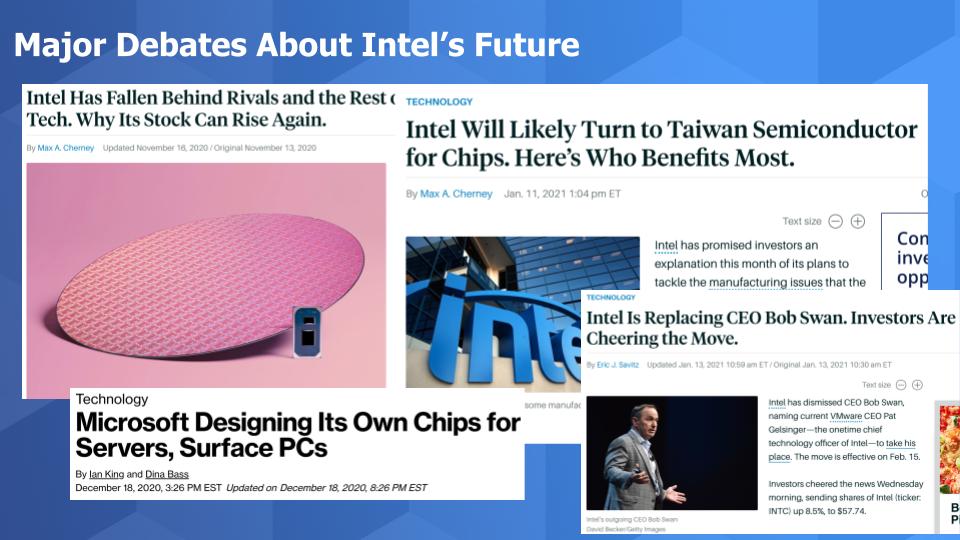
Here are some recent headlines and comments within that sum up the sentiment:
Intel Will Likely Turn to Taiwan Semiconductor for Chips. Here’s Who Benefits Most (Barrons).
Microsoft Designing Own Chips for Servers, Surface PCs (Bloomberg).
Intel Has Fallen Behind Rivals and the Rest of Tech. Why Its Stock Can Rise Again (Barrons).
Intel is Replacing CEO Bob Swan. Investors are Cheering the Move (Barrons).
Here are some of the comments from the articles and quotes from various analysts.
Intel has indicated a willingness to try new things, and investors expect the company to announce a hybrid manufacturing approach in January. Quoting CEO Swan “What has changed is that we have much more flexibility in our designs, and with that type of design we have the ability to move things in, and move things out…and that gives us a little more flexibility about what we will make, and what we might take from outside.”
Let’s unpack that a bit. Intel we know has a highly integrated workflow from design to manufacturing and production. But to us, the designers are artists and the flexibility one would think would come from outsourcing manufacturing to give designers more options to take advantage of 7nm or 5nm process technologies, versus having to wait for Intel manufacturing and live by its constraints. It used to be that Intel’s process was the industry’s best and it could supercharge a design or even mask certain design challenges so that Intel could maintain its edge; but that’s no longer the case.
Here’s the sentiment from an analyst from Citi analyst Daniel Danely:
Danely is confident that Intel’s decision to outsource more of its production won’t result in the company divesting its entire manufacturing segment. He cited three reasons: 1) it would take roughly three years to bring a chip to market…2) Intel would have to share IP and 3) It would hurt Intel’s profit margins. He said it would negatively impact gross margins by 10 points and would cause a 25% decline in EPS.
To this we would say: 1) Intel needs to reduce its current cycle time to go from design to production from 3-4 years down to under 2 years; 2) What good is intellectual property if it’s not helping you win in the market? and 3) Profitability is nuanced as the UBS analyst below explains.
Here’s the take from UBS analyst Timothy Arcuri. He says:
“we see no option but for Intel to aggressively pursue an outsourcing strategy…” He wrote that Intel could be 80% outsourced by 2026. Just going to 50% outsourcing he said would save the company $4B annually in CAPEX adding 25% to free cash flow.
So maybe Gelsinger has to sacrifice gross margin and EPS for the time being, reduce cost of goods sold by outsourcing manufacturing, lower his CAPEX and fund innovation in design with free cash flow.
Our Take – A Radical Change in Strategy is Needed
While we completely agree that in the near to mid-term, Intel’s fortunes won’t be magically reversed, we believe Pat Gelsinger needs to look in the mirror and ask:
what would Andy Grove do?
Grove’s quote, “only the paranoid survive” is famous. Less well known are the words that preceded that quote:
Success breeds complacency. Complacency breeds failure.
Incremental Change Will Only Delay the Inevitable
Intel in our view is headed on a path to a long drawn out failure if it doesn’t act. It simply can’t compete on cost as an integrated manufacturer because it doesn’t have the volume. Period.
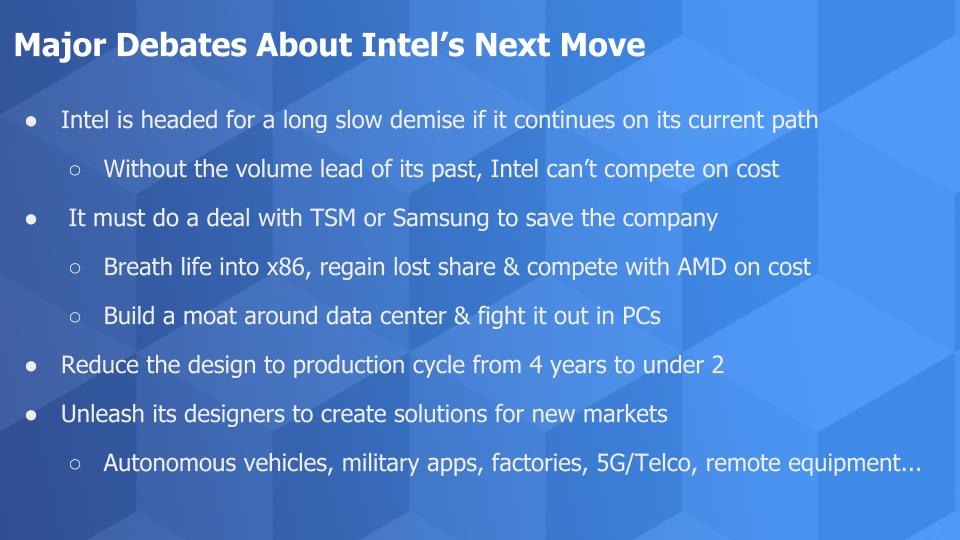
So what will Pat Gelsinger do? We’ve done close to 30 interviews on theCUBE with Pat. And we just don’t think he’s taking this job to make some incremental changes to Intel to steady the ship and get the stock price back up. Why would that excite Pat Gelsinger? That’s definitely not what Andy Grove would want. Pat’s certainly not in it for the money.
No, Pat Gelisinger is a visionary with a deep understanding of tech, architectures, trends, markets, people and society. He’s a dot connector. And he loves Intel– he’s a legend at the company.
A Major Strategic Partnership With TSMC or Samsung
Here’s what we strongly believe. We think Intel must do a deal with TSMC or Samsung – perhaps a joint venture or some type of innovative structure that both protects its IP and secures its future. Both of these manufacturers would love to have a stronger presence in U.S. markets where Intel has many manufacturing facilities. They may even be willing to take a loss to more deeply partner with Intel.
In our view, Intel needs to get to 5nm within 2 years to remain cost competitive and defend its base.
It can’t do this in our opinion without a strategic manufacturing partnership. If it tries to go it alone, the costs of introducing next generation technologies will be so expensive it will bankrupt the company. How’s that for paranoia?
To be clear we believe that core Intel should get out of the business of manufacturing semiconductors. Set up a JV, spin the venture off so you can profit but focus the core company on design.
This will allow Intel to better compete on a cost basis with AMD, defend its data center revenue…and fight the fight in PCs, better preparing for the coming onslaught from Arm.
Then go on Offense and Remake Intel from the Inside
Intel should put a laser focus on reducing its cycle times and unleashing its designers to create new solutions. Let a manufacturing partner who has the learning curve advantages enable Intel designers to innovate and extend ecosystems into new markets. Autonomous vehicles, factory floor use cases, military, security, distributed cloud, the coming telco explosion with 5G, AI inferencing at the edge. Just think about the opportunities for Intel in 5G, which Intel has pegged as an $18T opportunity.
Bite the bullet and give up on yesterday’s playbook and reinvent Intel for the next 50 years. That’s what we’d like to see and that’s what we think Gelsinger will conclude when he channels his mentor.
We sincerely wish the best for Pat, the people at Intel and the continued success of a great American company.
Many thanks to David Floyer for his contributions to this post and his excellent research on this topic over the past seven years.
What do you think? Please comment on our LinkedIn posts.
Other ways to Ways to get in touch: Email david.vellante@siliconangle.com | DM @dvellante on Twitter |
Remember these episodes are all available as podcasts wherever you listen.
Don’t forget to check out ETR for all the survey data.
Thanks, be well and we’ll see you next time.
Watch the video analysis:
Photo credit: SiliconANGLE Media


